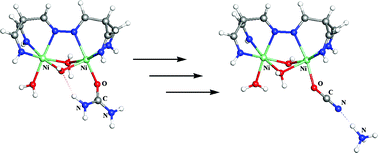Abstract
Density functional theory calculations were used to examine the role of the urease model complex [Ni2(bdptz)(µ-OH)(µ-H2O)(H2O)2](OTs)3
(A)
(bdptz = 1,4-bis(2,2′-dipyridylmethyl)-phthalazine; OTs = tosylate) in the degradation of

* Corresponding authors
a
Department of Chemistry, P.O. Box 30012, Texas A&M University, College Station, TX 77842, USA
E-mail:
hall@science.tamu.edu
Fax: 979 845 2971
Tel: 979 845 1843
Density functional theory calculations were used to examine the role of the urease model complex [Ni2(bdptz)(µ-OH)(µ-H2O)(H2O)2](OTs)3
(A)
(bdptz = 1,4-bis(2,2′-dipyridylmethyl)-phthalazine; OTs = tosylate) in the degradation of

 Please wait while we load your content...
Something went wrong. Try again?
Please wait while we load your content...
Something went wrong. Try again?
C. Beddie, C. E. Webster and M. B. Hall, Dalton Trans., 2005, 3542 DOI: 10.1039/B505210F
To request permission to reproduce material from this article, please go to the Copyright Clearance Center request page.
If you are an author contributing to an RSC publication, you do not need to request permission provided correct acknowledgement is given.
If you are the author of this article, you do not need to request permission to reproduce figures and diagrams provided correct acknowledgement is given. If you want to reproduce the whole article in a third-party publication (excluding your thesis/dissertation for which permission is not required) please go to the Copyright Clearance Center request page.
Read more about how to correctly acknowledge RSC content.
 Fetching data from CrossRef.
Fetching data from CrossRef.
This may take some time to load.
Loading related content
